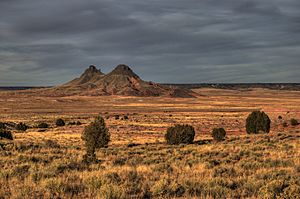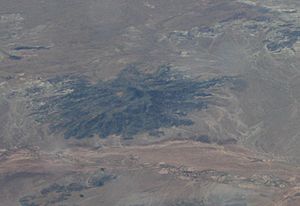Hopi Buttes volcanic field facts for kids
The Hopi Buttes volcanic field is a special area in northeastern Arizona. It is mostly found on the Navajo Nation near the town of Dilkon. This area is part of the Colorado Plateau.
A "volcanic field" is a place with many volcanoes. The Hopi Buttes field is "monogenetic." This means each volcano erupted only once. The field covers about 965 square miles. It has around 300 interesting volcanic features. These are called maars and diatremes.
Contents
What are Maars and Diatremes?
Maars and diatremes are types of volcanic craters. They form in a unique way.
How Maars Form
Imagine hot, melted rock (called magma) rising from deep inside the Earth. When this magma hits underground water, it causes a huge explosion! This explosion creates a wide, shallow crater called a maar. It looks a bit like a big bowl in the ground. The explosion mixes volcanic ash and rock with the dirt and sand from the area.
How Diatremes Form
Below the maar, there's a pipe-like structure called a diatreme. This pipe is where the magma traveled up. It's filled with broken rock from the explosion. Over millions of years, wind and water can wear away the softer rock around the diatreme. This leaves the harder diatreme standing tall. It often looks like a hill or a "butte."
The Rocks of Hopi Buttes
The rocks in the Hopi Buttes field tell a story. In the eastern part, you can see the shallow maar deposits. These are made of volcanic ash and sediments from an ancient lake. This lake existed millions of years ago. It was part of something called the Bidahochi Formation.
In the western part of the field, you can see the deeper parts. Here, the buttes are mostly the hard feeder diatremes. These are made of special volcanic rocks. They formed from unique types of magma.
When Did They Form?
Most of the volcanoes in the Hopi Buttes field erupted a long time ago. This happened between 8.5 and 6 million years ago. The most recent eruption found so far was about 4.2 million years ago. That's even before humans were around!



